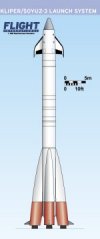Wind tunnel testing of the six-crew reusable spacecraft Kliper is ongoing despite the decision not to use the vehicle for a European Space Agency (ESA), Russian Federal Space Agency (FSA) manned transportation system study.
Originally a bid proposal to win FSA’s reusable manned spacecraft tender, Energia and its two competitors lost when the tender was cancelled after ESA declined to support a winged vehicle.
However Energia intends to develop and test Kliper by 2015 and field it in 2016. But some technology maturation has to be accomplished before a final full scale development decision is taken.
“We are testing a 1:20 scale down model of the wing [in a wind tunnel],” says Energia’s International Space Station, Automated Transfer Vehicle and Clipper directorate’s head of Clipper division Vladimir Daneev, speaking to Flight International exclusively at the Farnborough air show.
 |
|---|
In the wind tunnel the wing is being subjected to various mach numbers, including transonic and hypersonic speeds.
This work furthers aerodynamic studies conducted with Sukhoi for the last three years. Thermodynamics research has also been carried out to understand thermal loads.
Computational fluids dynamics analysis of Kliper’s latest design has produced positive results, with lower heat levels than the configuration previously seen.
Daneev expects Kliper’s thermal protection system (TPS) to be similar to his company’s Buran shuttle’s and NASA’s Space Shuttle. The TPS would use carbon-carbon and carbon-silica tiles. Ceramics would be used for areas where heat levels do not get too high.
Kliper could be launched on the yet-to-be-designed Soyuz-3 launcher.
Source: Flight International























